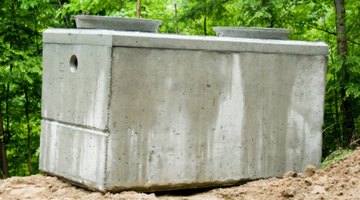How to find your Septic Tank Cover in 3 Steps
It should be easy to keep track of something as large as a septic tank, but in fact, the opposite is usually true. After several years of sitting undisturbed in your yard, the soil above it has settled and the ground cover effectively camouflages it, so finding one usually requires some detective work.

Even after you do manage to find the tank, you still have to locate the cover before you can service it. Using the process of logical deduction and two helpful tools, though, you should be able to do it without wearing yourself out with a shovel.
Things You Will Need
- Site plan for your property
- Tape measure
- 6-foot length of re-bar
- Sledge hammer
- Metal detector
- Shovel
Tip
Septic tanks often have two covers, one for cleaning the tank and one for servicing the pump. If you don't find the one you need, use the metal detector to find the other one. If you can't find a site plan, find the sewer clean out and excavate to find in which direction it runs. Begin probing with the re-bar in that direction until you find the tank.
Warning
Stop hammering on the re-bar as soon as it encounters resistance. If your tank is plastic, you may damage it. If you've only encountered a rock, you'll know that when you probe a short distance away.
-
Consult a site plan for your property that specifies the location of the tank. If you don't have one on hand, you can look it up in the records of the county building department where the contractor who installed it was required to file it. Note the relative orientations of the tank and your house and the distance of the tank from the side of your house from which the sewer exits.
-
Locate the sewer clean-out on the side of your house and measure the specified distance in the direction of the tank. Begin probing for the tank at that point by driving a 6-foot length of re-bar into the ground with a sledge hammer. As soon as the re-bar encounters an obstacle, stop hammering and excavate a foot or two further on. Continue doing this until you can drive the re-bar deeper, signifying you've reached the end of the tank. Find both ends of the tank in this way and mark them.
-
Run a metal detector over the area you marked out to find the cover. It is usually metal or at least has some metal parts. If the tank has an effluent pump, which is always located under the cover, the metal detector will also sense that. Begin digging at the place where you get a positive reading.
The Drip Cap
- It should be easy to keep track of something as large as a septic tank, but in fact, the opposite is usually true.
- After several years of sitting undisturbed in your yard, the soil above it has settled and the ground cover effectively camouflages it, so finding one usually requires some detective work.
- Run a metal detector over the area you marked out to find the cover.
- It is usually metal or at least has some metal parts.
References
Writer Bio
Chris Deziel has a bachelor's degree in physics and a master's degree in humanities. Besides having an abiding interest in popular science, Deziel has been active in the building and home design trades since 1975. As a landscape builder, he helped establish two gardening companies.
Photo Credits
- Jupiterimages/Photos.com/Getty Images
- Jupiterimages/Photos.com/Getty Images
More Articles



